MARBLE Artwork - Gianfranco Paulli Sculptor
Main menu:
- HOME PAGE
- Separatore 1
- THE SCULPTOR
- CREATION
- Separatore 9
- OPERA
- Separatore 8
- THE NOBEL
- Separatore 11
- IN THE WORLD
- Separatore 10
- CONTACTS
MARBLE Artwork
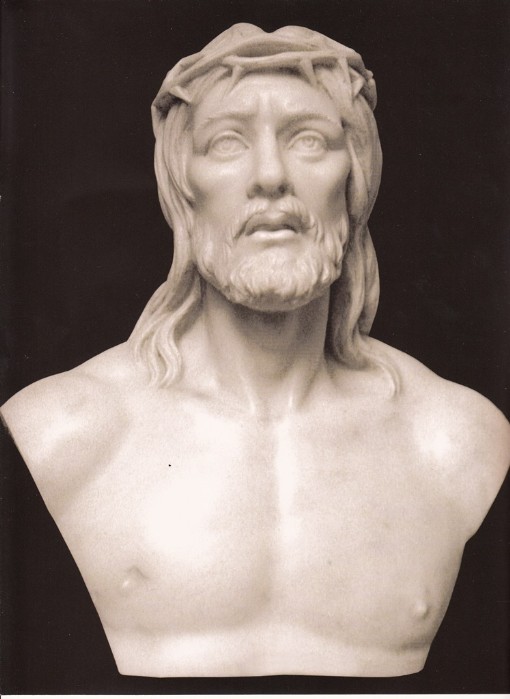
ANCIENT WORKING "THREE COMPASSES"
History
This processing method was used by the ancient Greeks in Classicism (Golden Age of Pericles). It is said that Phidias and other sculptors and stonemasons, who worked on the Acropolis of Athens building, they used the three compasses to return the points from plaster to marble block modeled indicated for riproduzione.Il modeled which could be: Figure frieze, relief, and c. He was first created by the sculptor in clay and then stored in two different ways: the first consisted in performing negative molds in plaster and then modeled inside the clay to the desired thickness. When the clay was dry, the form was being liberated from the plaster mold and the sculptor completed the work with the finishing touches. A ultimate finish, the work was being cooked in the ovens, thus becoming clay.
The second method consisted in performing copy of the molded plaster. Since the white color chalk, the sculptor had a precise perception of the volumes for all the time necessary to the reproduction of the marble.

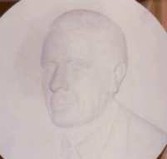
clay modeling gypsum copy
Chalk, as an intermediate material between clay and marble, gives greater security during the work whilst that from clay; because the plaster reproductions has an inside tow or hemp that protect it from shock and breakage. Moreover, the plaster copy is light and handy, easy in the movements, provides a white surface where the pencil mark is highlighted more. The artist then has the option, when work, to keep the work in plaster casts (deposit of gypsum) of which we have a regional example, in Possagno (VI): The collection of plaster casts of Canova. And 'necessary to make a nod to the manner in which the artist takes the reference points from the molded (copy) of plaster to marble.
There are several methods which vary depending on the habits of the sculptor. The ancients put in correspondence to each point needed a tack, leaving the head extended out from the plaster surface. The use of tack was necessary because above that point so united the three extreme points of the three compasses. There was then the danger of altering the surface of the model. Currently he is working with pencil, because the processing method is changed: instead of the three compasses there is the reproduction machine (articulated arm).
For each point of reference chosen by the sculptor corresponds to a small pencil cross or a black dot; Once the point is shown on the marble (carved), it marks a small circle around the cross +; thus it is known that that point has already been produced.
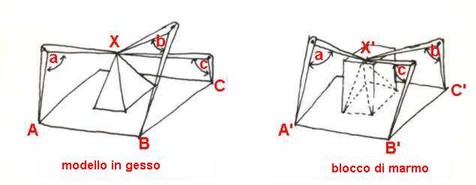
The machine for the reproduction or "articulated arm" was built on the principle of "three compasses" principle as modified and equally simplified. The operator with this ingenious invention he wanted to spare the dead time (laborers) (still necessary) of the ancient systems applications (methods) carryover of measures (three compasses, definitional, frontal planes, setting circles, square frames, wooden cages c) to devote more time to the purely creative work. The "articulated arm" has allowed us to speed up procedures and ensure greater accuracy in reporting points from plaster to marble pattern. By working with this system, the sculptor has given space for a greater virtuosity in the execution of the work, and you are allowed to invent sophisticated and complex methods, to give extraordinary artistic solutions (Baroque period and later).
The "machine" (sometimes improperly called pantograph) is composed of the following elements:
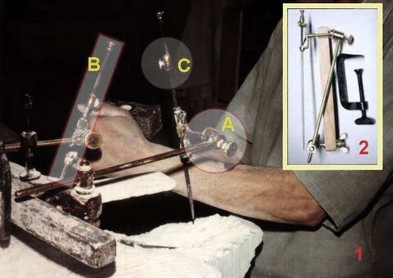
1. From the mobile part of the system, composed of a wooden arm which is fixed with the chuck on the "cross" and one or two arms (tubular brass), connected one with the other by so adjustable elbows that each arm can move freely and independently in all directions. Each arm is locked in the desired position by the sculptor by a throttle screw (fig.1/A).
2. From the adjustable tip: This is a thin rod of steel, about 25-30 cm long. and with triangular section. This tip is located at the end of the last arm of the "machine" (fig. 1/B). Its function is essential in the system.
For detection of any point of the plaster model and its subsequent transport (copy) in marble, adjusting the length approaching its tip to the mark (point), previously marked in pencil on the plaster model. In the other end of the rod is inserted an "indicator" (fig. 1/C) regulated by a screw that indicates the distance required to reach the desired point on the surface of the sculpture (marble). The "machine" is used both in the round sculptures for the bas-reliefs.

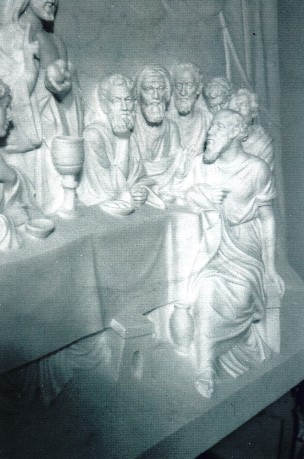
HOME PAGE | THE SCULPTOR | CREATION | OPERA | THE NOBEL | IN THE WORLD | CONTACTS | General Site Map



